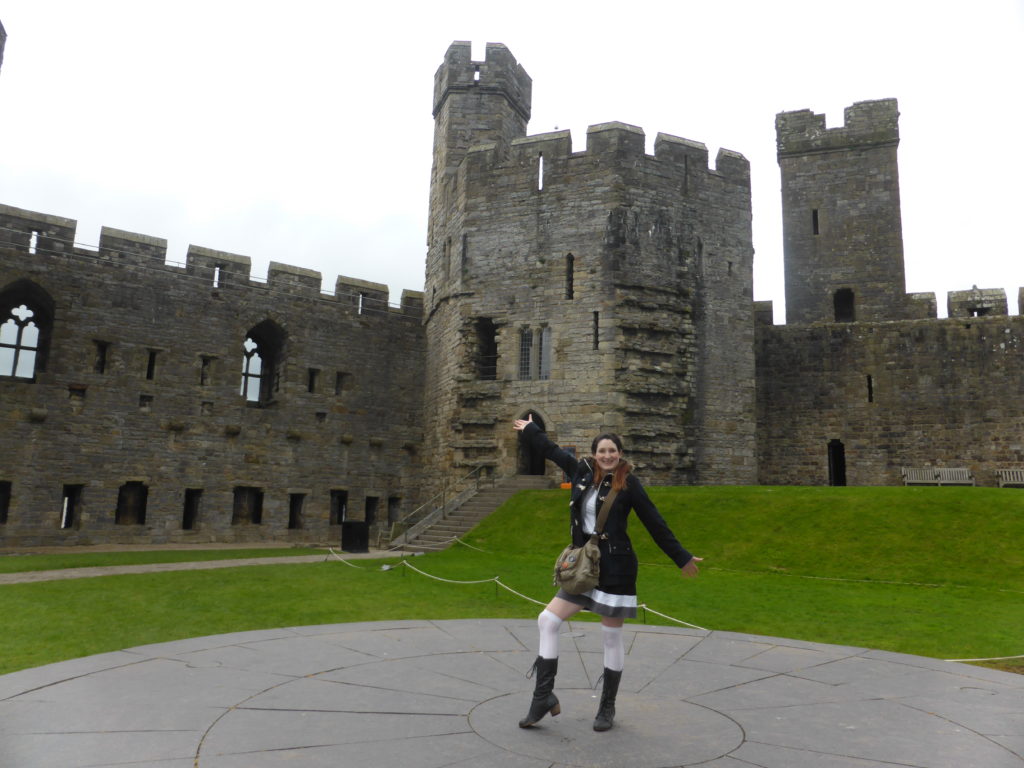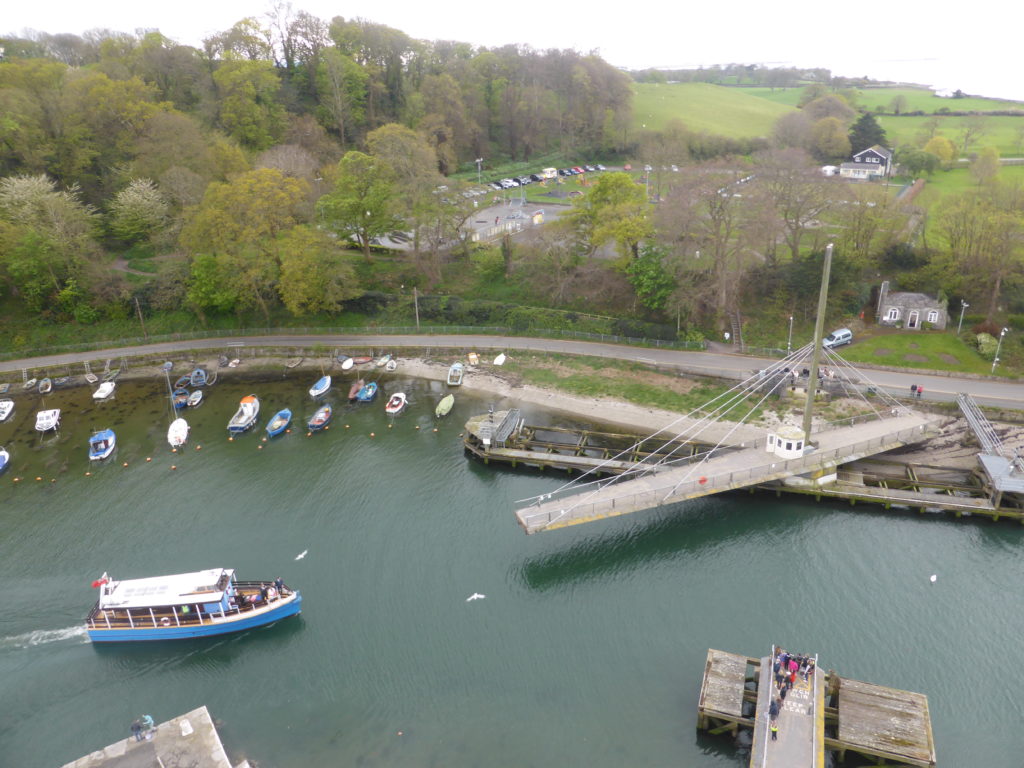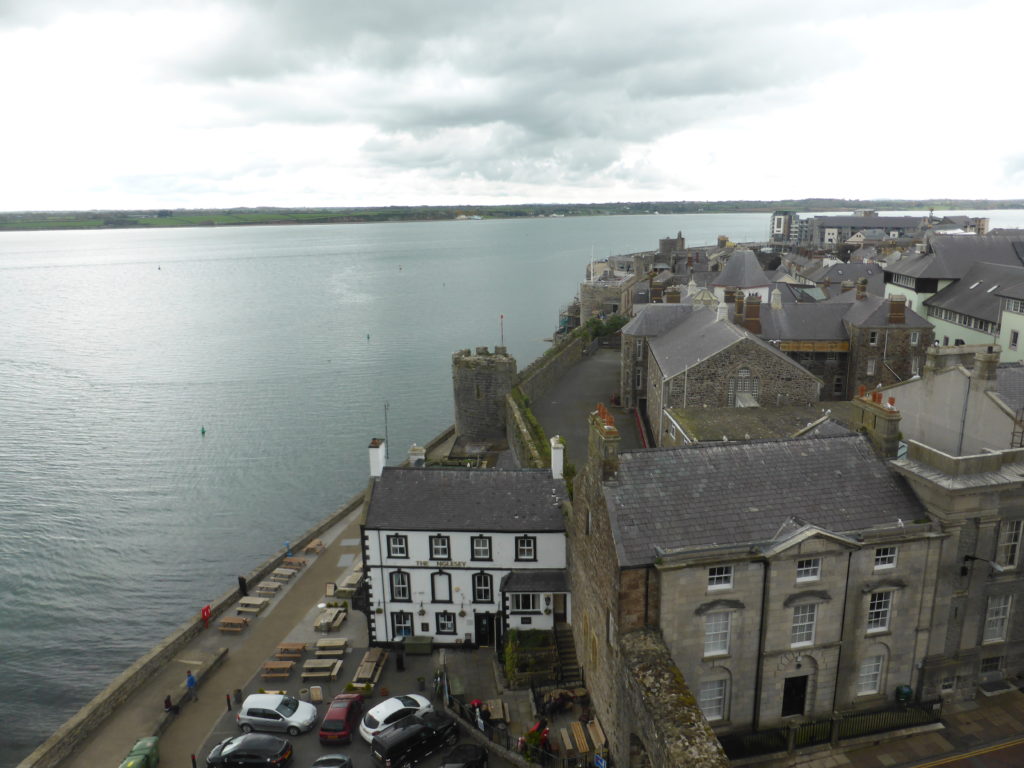Amazing Days Out: Caernarfon Castle
Caernarfon Castle – romantic images to inspire
This UNESCO World Heritage Site is one of the most impressive medieval fortresses in the world. Like Conwy, Caernarfon has a set of extremely well-preserved town walls. Enter through the East Gate into the atmospheric Palace Street, with its rustic atmosphere and Welsh flags everywhere. At the far end of the street, you see a tantalising glimpse of the great Caernarfon Castle. Castle Square is an open space next to it which contains a statue of David Lloyd George. Not only was Lloyd George the local MP, but he was also influential in bringing the investiture of the Prince of Wales to the castle. This brought Caernarfon Castle worldwide fame.

Caernarfon Castle is laid out like a figure of eight. Despite being over 700 years old, it has survived very well indeed. Its outer walls and towers are all still standing, though the inner buildings now just show the foundations. Start with the eight minute film show in the North-East Tower, which traces the castle’s history. Caernarfon Castle was built, along with other castles in Wales, by King Edward I after his victory in the Welsh War of Independence in 1282. However, the story of Caernarfon went back further to Roman times.

A Roman fort here led to a legend of a Roman Emperor who married a local princess, and ruled from Caernarfon. Many believe that Edward I chose Caernarfon carefully as the site of his castle in order to use many of the Welsh legends in his favour. The film goes on to show how Edward I’s son, the future Edward II, was born at Caernarfon Castle, and became the first non-Welsh Prince of Wales. There were other failed sieges in the years that followed the castle’s speedy construction, whilst it also saw action during the English Civil War.

It may have seen sieges, but nowadays it offers a peaceful atmosphere
These days, the site is run as a tourist attraction by Cadw. It has also seen the investiture of two Princes of Wales, including that of Charles in 1969. The Welsh slate dais on which Charles was invested still remains just outside the tower. The film is mega impressive, using a rounded screen and top of the range technology in order to tell the story. Another bonus is the dark and atmospheric room in which it is situated.

After it finishes, take the opportunity to admire the view through the Queen’s Gate. There are great views over the docks. On our visit, the castle was filled with a bunch of costumed medieval characters. We recognised them as the castle’s staff, including the curator John, who we had met on entry! It is great to see how everyone gets involved in providing a great experience for visitors. A mini-show was beginning, with a bunch of young children kitted out with bows and arrows!

The children were taught how to use them by two rather Blackadder-ish characters. This in itself was hilarious as the children were mostly too young to have any clue what was going on! The commander had them all lined up at the arrow slits, ready to shoot at passers-by, or potential invaders.

Start your proper tour of the castle by admiring the King’s Gate, through which you entered the castle. It is apparent that this was once a very strong gateway. There is evidence of portcullises, arrowloops, and murder holes providing extra defence mechanisms. You can access the upper part of the gatehouse from a doorway here. It is clear that a lot of thought went into the castle’s design, as there are doorways and corridors everywhere. This is a castle you can easily get lost in!

Caernarfon Castle is fantastic for couples with a sense of adventure
A very thick window offers great views of the Eagle Tower. Cadw’s reluctance to ruin this historic site with over-zealous health and safety installations is welcome. You could easily fall here, as well as in many other places of the castle. Therefore, it is important to be careful where you are going. Some of the arrow slits in the castle walls are double ones. This allows two archers to shoot through the same hole, which is a clever idea. Also up here is a chapel, signified by its sink.

Back on the ground, make sure to admire the Kitchens, which are much better preserved than at Conwy Castle. Although on first glance it appears that only the foundations remain, the area offers many fascinating discoveries. For example, you can see where two copper cauldrons would have been set against the wall, with fireplaces underneath to heat them. You can also see evidence of medieval drainage, with remains of lead piping even still visible.

The Kitchens are set against the Well Tower, so first of all descend the stairs to stand at the bottom of the tower. No floors remain in this tower, so you can see details of all of the former rooms at once. After heading back up to ground level, climb the Well Tower to find the 50 feet deep well that gives it its name. It is very dark at first, but a sensor can be triggered which lights it up. Very pretty views can be found up here across the wall walk. It is possible to take the wall walk to the part above the chapel, where you can see the impressive foundations for a seemingly never completed large hall.

Look at those views! (You may catch yourself saying that a lot)
Continue onwards to the North-East Tower. The views at the tops of all of the towers are just sensational, and offer romance of the highest level. Back on the ground, head towards perhaps the most impressive of all the castle’s towers – the Eagle Tower. With its three lofty turrets, it is clear that this one is rather special. Indeed, there just seems to be something more luxurious about the provisions inside. It was built for Edward I to live in. The basement shows evidence of the planned Water Gate, though it was never completed. You won’t believe how thick the walls are down here. If you climb up towards the arrowloop you will have to walk over to it!

The ground floor contains a striking exhibition called ‘Game of Crowns’. It is a life-size chess board that fills the room. Roughly life-size pieces based on major players in the wars between the Welsh and English take the squares. These wars decided the fate of the Prince of Wales name in medieval times. The Welsh are coloured red, whereas the English are white. Pieces are taller or smaller depending on their success in those battles, whilst they face those that they fought with. It is a fascinating way to follow the history, if a little confusing when the room is busy.

Also inside the room are mementos from Prince Charles’ investiture at the castle, along with a video of the occasion. This is well worth watching. The mementos include tickets, and spectactor seats. Even more impressive is the Queen’s Throne and the kneeling stool where Charles did homage to the Queen. A former Prince of Wales’ refusal to do homage to Edward I in the 1270s triggered off his invasion of North Wales in the first place.

The first non-Welsh Prince of Wales was born here
The main chamber on the first floor contains another exhibition, about the life of Queen Eleanor of Castile. Eleanor was Edward I’s wife, who gave birth to the future Edward II here in the castle. A small room just off from here was believed to be the birthplace, and has the arms of the future Edward VII inserted into the window. He too was invested as Prince of Wales here. The exhibition is very interesting, with origami style scenes beautifully telling the story.

The room at the top is left empty, so you can really get a feel for the size of these impressive rooms. The fireplace is so large it can be climbed into. You can also go up to a little balcony overlooking the room for photos and a different view. From here, head to the roof of the tower, because that too has remarkable views. The roof of this tower is filled in, so it has a slightly different feeling to most of the others. From up here, if you are lucky you can watch the swing bridge open to allow a boat through on the river.

You can climb to the top of the west turret as well. Up here, on the battlements, are weathered stone figures. You can make out that one is an eagle, hence the name of the tower! The views up here are unbeatable. After retracing your steps back down to the courtyard, enter the Queen’s Tower. This and the adjoining Chamberlain Tower house the Royal Welch Fusiliers Museum. Skip that for now, because you will want to climb the steps to access the wall walk.

It is so easy to get lost in Caernarfon Castle – not a bad thing!
There are actually two levels of wall walks between this tower and the Eagle Tower. Admire the views from both, before negotiating the long, dark, and mysterious corridors that lead all the way to the other end of the castle. This place is seriously confusing in its layout, therefore very easy to get lost. If you can somehow make your way across to the Black Tower, you will find a very iconic exhibition. It uses a model of King Edward I’s head, cut into four, to tell the stories of Welsh legends that inspired him to set up his Royal palace-fortress here in Caernarfon.

Take time to see the Cistern Tower, which contains a large rainwater tank made from stone. This collected the rainwater from the nearby roofs. The wall walks end around this point rather abruptly. Backtrack in order to return back to ground level and head through the Queen’s Gate. This formidable gateway wasn’t completed, which makes it rather unusual. You can get great views of the town from its balcony from where Prince Charles addressed the people as Prince of Wales.

Walk up the North-East Tower next. From the top, you can see the adjacent Watch Tower, which once acted as a look-out point. Having finished your tour of the castle, enter the Royal Welch Fusiliers Museum. This fascinating museum is housed in the Queen’s Tower and the Chamberlain Tower. The story of Wales’ oldest infantry regiment is told in detail here. They date back to 1689! There are plenty of chances to dress up in period army costumes throughout the rooms. The collection of war medals is astonishing. It includes Victoria Crosses, and an oak leaf medal that was awarded to those who got a mention in dispatches, as Amy’s Grandfather did.

Allow some time for the Royal Welch Fusiliers Museum
Many famous battles and conflicts that the regiment fought in (including the American War of Independence, and Napoleonic Wars) are relayed with the help of models, artefacts and information boards. Of course, the regiment goat is featured too! Some of the items that are included seem almost mystical, including the Burma Bell. You could easily spend a lot of time in here if you are interested in military history.

Once you have left the castle, you can take a walk around the town walls. Make sure to notice the weathered statue of Edward II above the entrance to the castle. It was erected in 1320! The town walls are comprised of eight towers and two gateways and date from the same time as the castle. Across the road you can see the walls end. Down Hole in the Wall Street, you can take a peek at the inside face of the walls. Here you can see the remains of a staircase.

You can then just stroll around the outside of the walls the rest of the way. Just outside is Bar Bach, the smallest bar in Wales. Head underneath the bridge that sits beneath the East Gate, which was the main entrance to the town. An ancient looking chapel sits within the bridge. The buildings around here are painted in pleasing pastel colours, which provide a lovely atmosphere. The stretch of walls here is remarkably well-preserved, and you can clearly see the arrowloops.

The best views of the Castle are from across the water
There is a modern opening to the town here, right next to the Black Boy Inn. Two gates later is the chapel of St Mary, which was built in the early 1300s and still survives. You will come next to the town quayside, which has a real medieval atmosphere. It is a gorgeous place for a stroll. When you get around to the swing bridge, make sure to cross over for some of the best views of the castle. It looks extraordinary from over there. The river Seiont will be in the foreground along with all of the boats, many ruined themselves.

After crossing back over, continue the walk around to the Queen’s Gate. It is well worth it. We loved Caernarfon Castle, and can easily see why it is held in such high regard. There are few more romantic images than ruins. Just ask Turner and Wordsworth! The ruins at Caernarfon Castle are among the best in the world. You and your partner should definitely visit. Depending on your interest level, it would be easy to spend a full day at the castle.

Have you been to Caernarfon Castle? Can you think of a more romantic castle?



